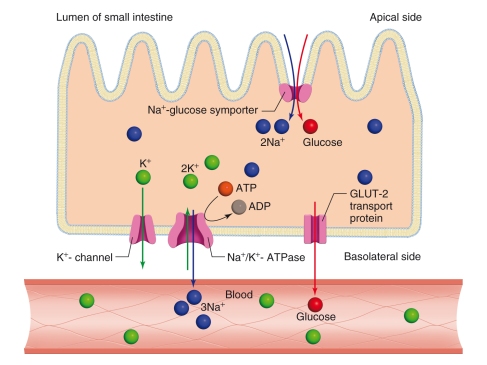Rather than go through the motions of profuse apology and promises to write more in future, let’s just say I was kidnapped by anti-science, anti-blog, anti-fun desert pirates and leave it at that? OK? OK.
Let’s say I ate a cookie. After all the business of masticating, saturating and dissolving said cookie, it comes time to absorb its nutrients. The bulk of this occurs in the small intestine, which is not only highly folded, but the inner surface is covered in small, finger-like projected villi), which in turn are covered in even smaller finger-like projections (microvilli). It is through these that I can absorb the various carbs and sugars this digested cookie has to offer. “But how?!” You ask. Well, I can explain! And later you can explain to me how I can hear you over the internet.
Anyway, you have all these nutrients hanging out in the lumen (the open space inside the intestine) of the small intestine that need to get from there to the blood stream. But first they have to get through the epithelial cells of the microvilli. They can’t simply diffuse (see here for a diffusion review), the concentration of nutrients within the epithelial cells is too high to allow diffusion. This is where membrane transport proteins come in handy. These are proteins embedded in the lipid bilayer of the cell that, through various means, transport molecules and ions from one side of the membrane to the other. In the small intestine in particular, there is a class of transporters called sodium-dependent secondary active transporters. These proteins use sodium to power the transport of various molecules such as carbs, sugars and amino acids into the epithelial cells of the microvilli. Although many work in similar ways, I’m going to use the sodium-glucose symporter as an example.
First off, let’s have a few definitions so that I don’t leave all y’all in the dust. Secondary active transport involves moving one molecule into a cell against its gradient by coupling it with another molecule or ion that is moving (into or out of the cell) with its gradient. So say you’re trying to get into a club, but the room is too full, so either a friend of yours leaves so that you can get in, or you have an assertive friend with you that drags you in whether there’s room or not. A protein/bouncer that allows that first example would be an antiporter (2+ molecules moved in opposite directions), while the second would be a symporter (2+ molecules moved in the same direction). In the case of the sodium glucose symporter, two sodium ions act as the pushy friend to get glucose into the hopping club that is the epithelial cell. Inside the cell there is a high concentration, but a low (and carefully maintained) concentration of sodium. Sodium’s movement down its gradient actually provides the energy to power glucose transport (or pay glucose’s cover, if you want to keep going with the club analogy).
To get into the blood stream, the process is much simpler. Blood glucose concentration is much lower than that of the epithelial cell, so diffusion is very possible. HOWEVER, glucose still needs help. Dissolved in the cytosol of the epithelial cell, it is hydrated; surrounded by a little cage of water molecules that would need to be stripped on in order for the glucose to pass through the hydrophobic lipid bilayer. Not a terribly favorable reaction. As a result, GLUT-2 transport proteins act to facilitate diffusion into the blood stream. They provide a hyodrophilic environment for the glucose to pass through. Many membrane transporters act as catlysts in this way, lowering the “activation energy” of transport for molecule and ions (much like enzymes catalyzing reactions).
Now that the glucose is successfully transported, there’s just a little housekeeping left. A sodium-potassium ATPase antiporter brings in two potassium ions and boots out three sodium ions. Unlike the sodium-glucose symporter, this is an ATP powered pump. Elsewhere, potassium channels allow for diffusion of potassium ions into and out of the cell to maintain concentration gradients.
Tune in next time and maybe I will explain how blood glucose levels are regulated.
But only if you’re all very good.
So watch it.
Source
Sholders, Aaron. “Types of Membrane Transport”. Principles of Biochemistry. Great River Technologies. 2013. eBook.
Sholders, Aaron. “Membrane Transport”. Biochemistry. Colorado State University. Fort Collins, CO. Jan 2013. Lecture
Photo credit: Sholders, Aaron. “Types of Membrane Transport”. Principles of Biochemistry. Great River Technologies. 2013. eBook.
